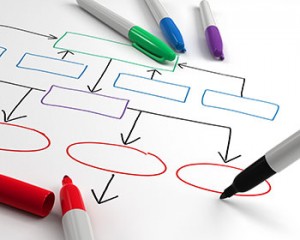Visitors to your website are looking for a quick and easy way to find information. To provide a user-friendly experience, the content on your site must be logically organized. So, how do you go about organizing web content? Let’s look at four basic methods for organizing web content.
Put it on paper

Using paper, sticky notes or a whiteboard are fast ways to capture ideas during a brainstorming session. This is especially useful during group meetings that happen early on during project planning. This process can help generate excitement for your project team. Just be sure to convert to digital files as soon as possible so ideas are not lost.
Take inventory
Take an inventory of all existing content. A spreadsheet is a great way to list all of your pages and their URLs. To make the list more valuable, add notes describing the page. Be sure to include the types of content you have on your site, including text, images, audio/video files, etc.
For website redesigns, this is a great opportunity to decide what content you want to keep, what needs to be refreshed, what needs to be created and what will be discarded.
Card sorting
Card sorting is an exercise that allows participants to group similar content. Start by listing each website page on an index card. Ask participants to sort the cards into logical stacks. This process allows you to understand how different people think about your content. Take note if there are cards people struggle with – you may consider removing that content or combining it on another page.
Create a site map

A visual site map illustrates the hierarchy of your website. A site map diagram helps to visually explain the relationships between pages. It serves as the blueprint for your website.
You can create your site map manually with pen and paper or you can choose from a number of third-party tools available online. One powerful diagramming platform available to UGA employees is Visio in Microsoft Office 365.
Organizing web content can be a challenging and time-consuming process, but it is a critical step toward creating a successful, effective website. Devoting time to content organization early in your project planning will lay a solid foundation for everything to come (including your visual design)!